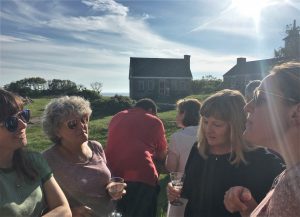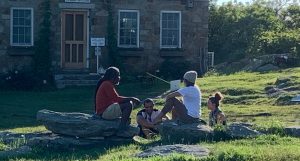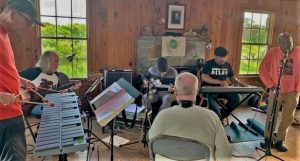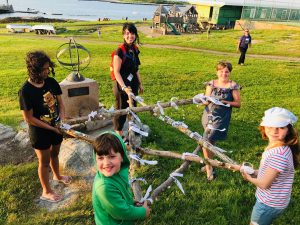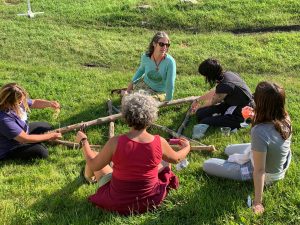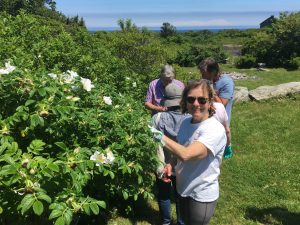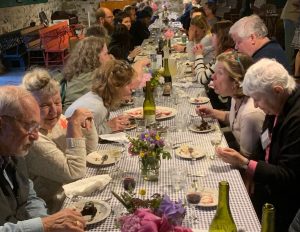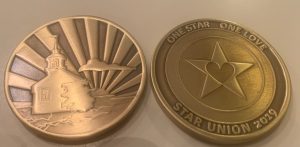This piece is an excerpt from It Is Time Now: Offerings from the Beloved Community Project, an educational resource produced in 2019 as part of Star Island’s Beloved Community Project. The Star Island Beloved Community Project is a journey SIC has begun as an organization to create a more inclusive and intentional community, to help spread more empathy and understanding in the world, and to become a more welcoming place for all people. We recognize and affirm that many have been on this journey for a long time, and we are excited to listen and learn as we continue on this important journey.
We sang our way through how difficult this is. It is not impossible to meet the challenge of anti-racism in our time but it is incredibly difficult. It requires a great commitment from us. That commitment comes at a cost. James Baldwin once said,
The day will come when you will trust you more than you do now. When you will trust me more than you do now. We can trust each other. I do believe… I really do believe in the New Jerusalem. I really do believe that we can become better than we are. I know we can. It’s just that the price is enormous and people are not yet willing to pay.
James Baldwin believed in the New Jerusalem. Until the end of his life, he was working towards it earnestly. For him, the New Jerusalem was that soul-rich state of mind in which it was possible to overcome the difficulties and challenges of our time—the difficulties of what Derrick Bell describes as the “permanence of racism” and the challenges of white supremacy culture.
How powerfully we have turned to confront these things. How passionately we have responded to honest critique. And, unfortunately, how ineffective we have been. We have been ineffective for one simple reason. It is not because we have been disinterested in anti-racism workshops. It is not because we have been unable to attend revolutionary love conferences. It is not because we have been unwilling to make long-term, structural commitments to doing the work of justice. We have been ineffective in our response to racism and white supremacy culture because we have failed to trust one another. We have yet to commit—soul-level deep—to the spirit’s call for freedom in our time.
This is the time of mass shootings—in a high school in Parkland, Florida; in a black church in Charleston, South Carolina; in a synagogue in Pittsburgh, PA. This is the time of the travel ban. This is the time of the border wall. This is a time in which the public trust has been badly broken. We are shattered from ourselves and from one another. We don’t know how to talk about it. In the presence of all that is broken, we don’t know how to believe in one another. We don’t know how to believe in ourselves.
This is a time of great heartbreak. If we are courageous, it can also be a time of great healing. It is up to us. We have to decide. We must choose. If we decide to surrender to heartbreak, we need to do nothing at all. What we are in the middle of doing now will get us there. If we choose to surrender to healing, we have to trust one another. Far more deeply, we have to trust ourselves.
James Baldwin said that this day would come and he was right—this day when we would learn to trust ourselves and one another. This is that day. This was what we found in the Project. This is the meaning that we made in beloved community. How did we meet the challenge of the New Jerusalem? How did we allow the best within us to blossom in this world of ours that has become so hostile and vitriolic? We sang our way through to beautiful things—trust, integrity, fairness, fidelity, freedom, dauntlessness and grace. This is what it takes to make us flower.
We sang our way through. We sang our way through the difficulties with the help of Ferron. We sang our way through the challenges with the help of Joan Baez. We sang our way through to freedom with Richie Havens. In our spirit, we sang of freedom…
Freedom, freedom…
I got a telephone in my bosom
and I can call him up from my heart
—Richie Havens
This is how Richie Havens talked about the call that is within us. In our study, we sang of challenge and we sang of amazing grace. With the help of Joan Baez, we sang,
A young man came to a house of prayer
They did not ask what brought him there
He was not friend, he was not kin
But they opened the door and they let him in
And for an hour the stranger stayed
He sat with them and he seemed to pray
But then the young man drew a gun
And killed nine people, old and young
In Charleston in the month of June…
We sang of the challenge in Charleston because we were concerned with our habits of storytelling. As Joan Baez sang,
We argued where to place the blame
On one man’s hate or a nation’s shame
Some sickness of the mind and soul
And how the wounds might be made whole
But no words could say what must be said for all the living and the dead
So, on that day and in that place, the President sang Amazing Grace
My President sang Amazing Grace
—Joan Baez (Zoe Mumford)
President Obama did not have the words. As eloquent as he is, he was almost speechless on the day that he memorialized Senator Clementa Pinckney on June 26th of 2015. At the site of those terrible murders, President Obama said that Clementa Pinckney,
…embodied the idea that our Christian faith demands deeds and not just words, that the “sweet hour of prayer” actually lasts the whole week long and that to put our faith in action is more than individual salvation. It’s about our collective salvation— that to feed the hungry and clothe the naked and house the homeless is not just a call for isolated charity but the imperative of a just society. What a good man. Sometimes I think that’s the best thing to hope for when you’re eulogized, after all the words and recitations and resumes are read, is to just say someone was a good man.
Because of the limits of words and theirs stories, the president sang out from his heart. He sang Amazing Grace.
How do you tell the stories that leave us speechless? The Beloved Community Project began to answer that question. We used seven tools of analysis—trust, integrity, fairness, fidelity, freedom, dauntlessness and grace. Of these, trust was the most important. Without trust, we lacked the ability to use the other six.
On June 17th of 2015, Dylann Roof entered a house of prayer. He entered Mother Emanuel African Methodist Episcopal Church on Calhoun Street in Charleston. Armed with a .45 caliber handgun, he took the lives of nine church members who were in Bible Study. Armed with a “sickness of the mind and soul,” he broke the heart of a nation. Armed with a story, he broke our hearts. What story was that powerful to him?
Three days after the shooting, The New York Times reported that an unsigned 2,444-word “manifesto” had been found online. It supposedly explained the shooting. It read,
I have no choice. I am not in the position to, alone, go into the ghetto and fight. I chose Charleston because it is the most historic city in my state… We have no skinheads, no real KKK, no one doing anything but talking on the internet. Well someone has to have the bravery to take it to the real world, and I guess that has to be me.
According to the “manifesto,” Roof was “truly awakened” by coverage of the shooting of Trayvon Martin. Continuing,
I read the Wikipedia article and right away I was unable to understand what the big deal was. It was obvious that [George] Zimmerman was in the right.
According to Wikipedia,
Wikipedia is a multilingual, web-based, free encyclopedia based on a model of openly editable and viewable content, a wiki. It is the largest and most popular general reference work on the World Wide Web, and is one of the most popular websites by Alexa rank. It is owned and supported by the Wikimedia Foundation, a non-profit organization that operates on money it receives from donors. Wikipedia was launched on January 15, 2001, by Jimmy Wales and Larry Sanger.
In many ways, Wikipedia has become the defining authority of the public story. But what is that story saying in the article is entitled “The Shooting of Trayvon Martin.”
There was a terrible question before us: What was it about this Wikipedia article that convinced Dylann Roof (or anyone, for that matter) that George Zimmerman was “in the right” when he shot and killed an innocent man. Regardless of whether or not Dylann Roof actually wrote his “manifesto” and without elevating the thoughts of a murderous and deeply troubled individual to the level of fact, the Beloved Community Project analyzed the Wikipedia article—the last one that was available before the shooting, the one that was edited on June 9th of 2015 by an online character named Faceless Enemy. We analyzed it intellectually. We analyzed it symbolically. We analyzed it energetically and were much amazed.
It took real courage to analyze this article. It took great strength. It took faith. Most deeply, it took trust, trust that we would survive our own analysis with our soul intact. Willfully or unwittingly, the Wikipedia article is ‘designed’ to break the reader. It breaks hearts. It breaks trusts. It breaks the possibility of healing. I am not being hyperbolic. Joan Baez sang,
We argued where to place the blame
On one man’s hate or a nation’s shame
Some sickness of the mind and soul
And how the wounds might be made whole
Our wounds are not made whole by reading the Wikipedia article. The Beloved Community Project was courageous enough to find out why.
Collectively, we read through the Wikipedia article. We read it thoroughly as one would a religious text. We did an exegesis…not to discover its sacred gifts but to make sense of the absence of them. We put the article on a series of notecards and spread it out on the floor so we could see it as a whole. When we analyzed the article, we used the seven spiritual tools—trust, integrity, fairness, fidelity, freedom, dauntlessness and grace.
After doing so, we raised unnerving questions:
1. To what degree was the Wikipedia article supportive of the actions of the shooter at the expense of the person that was shot?
2. How often was “The Shooting of Trayvon Martin” arguing in favor of the killer at the expense of an innocent, African American, seventeen-year-old kid?
And, most powerfully,
3. What is the public impact of this action (and the private impact) of this act of storytelling?
It took real courage to ask these questions. It took deep trust to answer them—trust that we would be able to hold each other though the pain of what we would discover, trust that we would survive the enormous spiritual price that we believed we were asked to pay.
What we discovered astounded us. We discovered that only 5% of the article was best analyzed with the tool of trust. The usefulness of our spiritual tools of analysis revealed themselves in the following way:
Trust 5%
Integrity 21%
Fairness 21%
Fidelity 23%
Freedom 2%
Dauntlessness 8%
Grace <1%
We systematically analyzed every aspect of the 14,998-word article and found that Trayvon Martin’s name was mentioned in 420 of the article’s 733 sentences. We found that George Zimmerman’s name was mentioned in 609 of the article’s 733 sentences (understandably, some sentences contain both names). We further discovered that of the 420 sentences that contain Trayvon Martin’s name, only 23 sentences conveyed meaning that was positive and 51 were neutral. So, of the 420 sentences that contain Trayvon Martin’s name, the overwhelming majority conveyed meaning that was negative—346 of 420 sentences. When mentioning the name of a murdered, unarmed and innocent man, the Wikipedia article edited by the online character named Faceless Enemy was negative about Trayvon Martin 82.4% of the time.
On the other hand, we found that George Zimmerman’s name was mentioned in 609 of the article’s 733 sentences. We further discovered that of the 609 sentences that contain George Zimmerman’s name, only 37 sentences conveyed meaning that was negative and 365 were neutral. So, of the 609 sentences that contain George Zimmerman’s name, the overwhelming majority conveyed meaning that was neutral or positive—572 of 609 sentences. When mentioning the name of a murderous, armed and guilty man (however “justifiably guilty”), the Wikipedia article was neutral or positive about George Zimmerman 93.9% of the time.
Dylann Roof may have pulled the trigger on nine innocent people at Mother Emanual African Methodist Episcopal Church in Charleston, South Carolina but the public story that inspired him (arguably) pulled the trigger on Trayvon Martin. What does this reveal about the baseline narrative of public life? How do we stop telling our public story in a way that justifies the senseless deaths of innocent people of color? By the grief that attends these questions, the Beloved Community Project was driven into reflection. What emerges from that reflection is still flowering. You can be part of a beautiful unfolding. You can be a part of the sure emergence of the New Jerusalem, that deep trust that overcomes the difficulties of what Derrick Bell describes as the “permanence of racism” and the challenges of white supremacy culture. You can be a part of the coming beauty.
In our spirit, we sang of freedom. In our study, we sang of finding ways that our wounds might be made whole. In our soul, we sang about the flowers on the willow tree. With the help of Ferron, we sang a song called, “The Return.” We sang,
For to lay my head on your restless arm
I take my cue from the willow tree
For it don’t break with just one storm
But bends with the strength that keeps it free
-Ferron
What strength keeps us free these days? James Baldwin said that the day would come when we would trust ourselves and one another more. He said that he believed that we could grow but that the price would be high. The price of our distrust is now enormous—at least, as enormous as the price of doing otherwise and arguably more. We can pay for heartache or we can pay for healing. The choice is ours, what will be. The Beloved Community Project made its decision to trust. That decision brought us a great deal of joy. Will you join us?

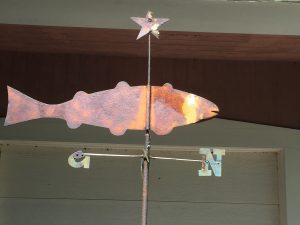
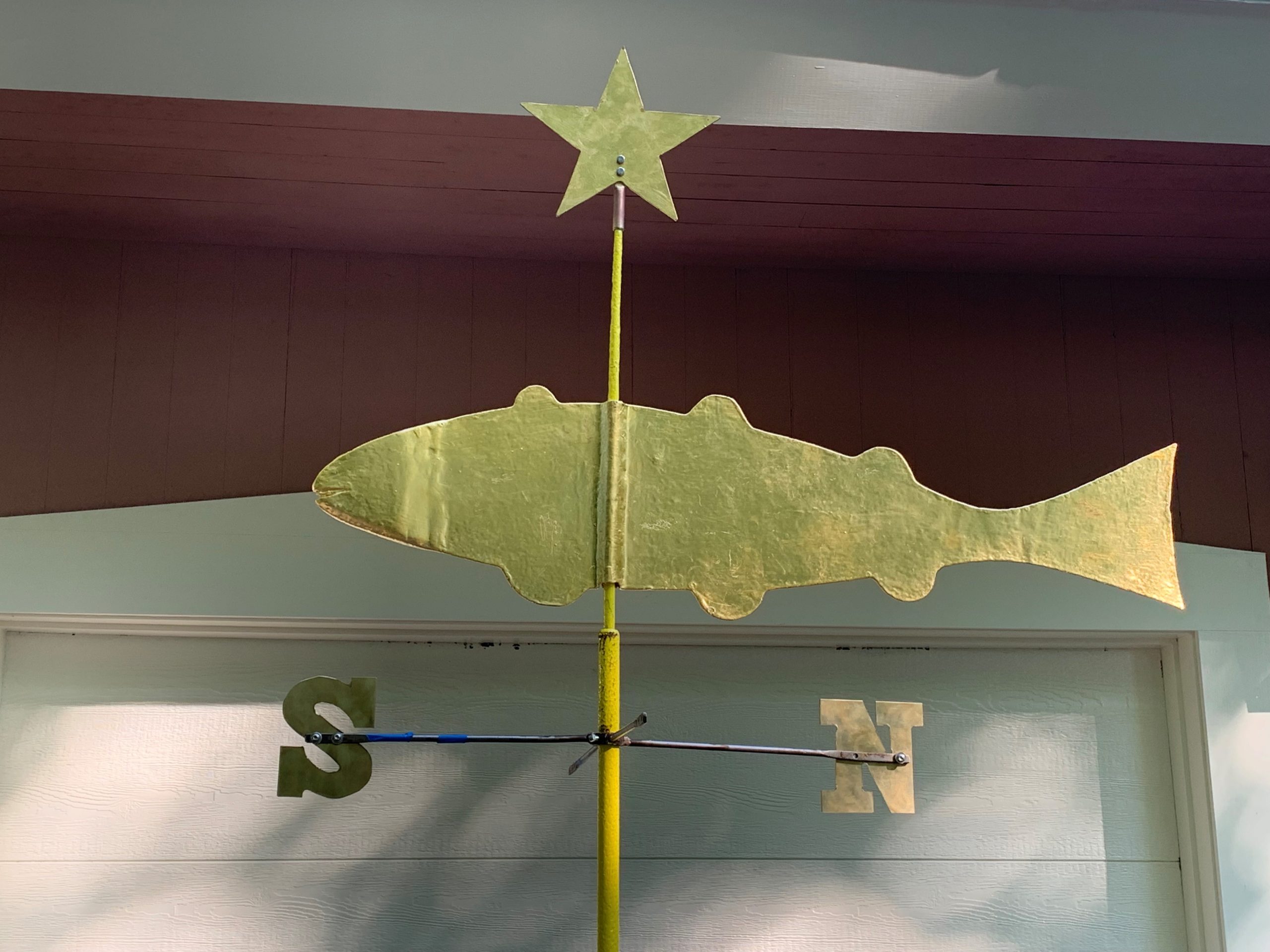
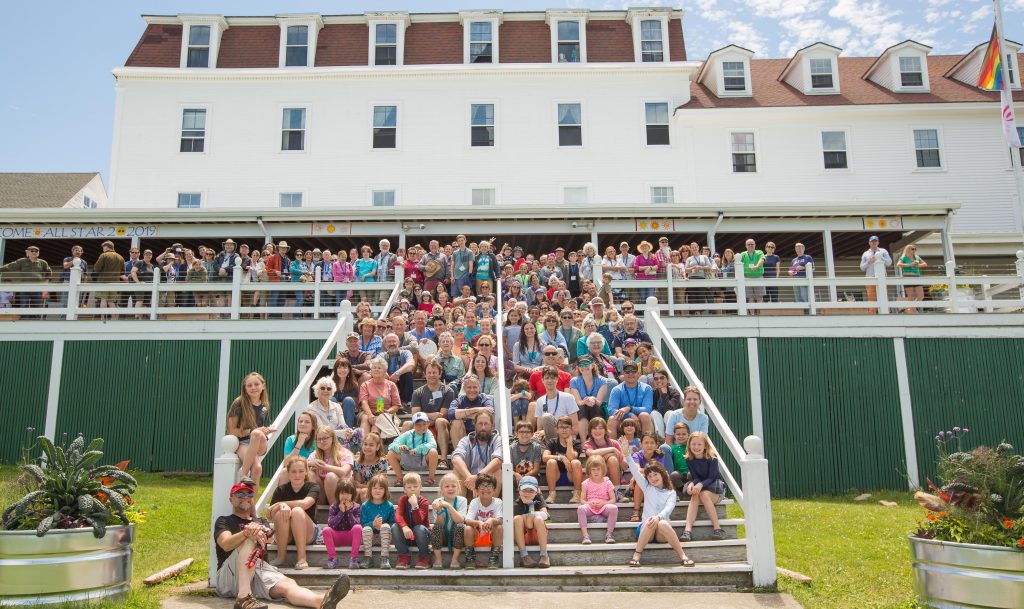
 All Star I Family Conference offers a multi-generational experience where shoalers old and new can explore matters of consequence while partaking in a community that is deep, creative, and family-friendly.
All Star I Family Conference offers a multi-generational experience where shoalers old and new can explore matters of consequence while partaking in a community that is deep, creative, and family-friendly.


